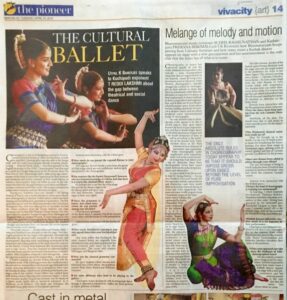My solo Bharatanatyam performance at the IIC Spring Festival of Dance (Passing on a Tradition: Guru and Disciple) on the 7th of April, 2016 at the main auditorium, India International Centre, New Delhi was received well by an audience of dance connoisseurs and critics. I presented compositions showcasing the various moods that the season of spring is associated with in the classical Bharatanatyam style. The presentation was carefully crafted with the valuable guidance of my guru, Smt. Geeta Chandran. It commenced with a famous poem by Suryakant Tripathi ‘Nirala’ titled ‘Vasant Aaya’.
Through a conversation between the nayika (heroine) and her sakhi (friend), this poem announces the arrival of the season of spring. Like a young woman at the pinnacle of her youth, the earth too is in full bloom. Leela Venkataraman, senior dance critic, writes in her review of the performance for the IIC Quarterly:
“Geeta Chandran’s fast-evolving Bharatanatyam disciple, Sneha Chakradhar, entered welcoming spring’s bounty, based on suryakat Tripathi Nirala’s Sakhi Vasant Aya, set to Basant Bahar score by Sudha Raghuraman, followed by a spirited nritta/abhinaya suite with convincing sancharis interpreting Swati Tirunal’s Karnataka Kapi varnam Sumasaya. The sakhi, pleading with Lord Padmanabha the case of her lovelorn friend waiting in vain for him, urges the he join her… The finale saw a Tillana in Rageshwari.”

The following is a link to dance critic U.K. Banerjee’s review of the festival, published in Vivacity, The Pioneer on 12th April, 2016.
http://www.dailypioneer.com/vivacity/melange-of-melody-and-motion.html
Banerjee writes: “As was evident from the recently-held IIC Spring Festival — Passing on a Tradition, Guru and Disciple, the two opposites, namely, representation and abstraction, were most clearly defined in Indian classical dances as nritya and nritta respectively. This came out most vividly in guru Geeta Chandran’a corpus at her institution Natya Vriksha, ably represented by Sneha Chakradhar… Sneha began with the poet Nirala’s famous poem: Vasant Aay set in raga Vasant Bahar. The cuckoo-calls, the peacock’s prances and the floral exuberance of the vernal season came through in her nritya very well. Next was an elaborate varnam in raga Carnatic Kafi, in alternate nritya and nritta, in picturesque choreography. Then there was a padam, in raga Suruti, to present in nritya a Khandita Nayika (querulous heroine): throwing away her faithless lover. Her final item, in contrast, was a brilliant tillana in pure nritta.”


